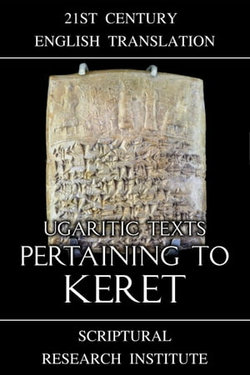Pertaining to Keret, also called the Legend of Keret, or the Epic of Keret is a collection of three tablets recovered from archaeological digs in the 1920s and 1930s at the ruins of Ugarit, a bronze-age city in northwest Syria, at the foot of the mountain Jebel Aqra on the modern Syrian-Turkish border. They date to Late-Bronze Era, specifically estimated to sometime around 1350 BC based on the name of the scribe Elimelek, who also transcribed the Ba‘al Cycle for King Niqmaddu of Ugarit. The story itself is set much earlier, and in a land far to the east of Ugarit, likely along the Khabur River in eastern modern Syria, and the Tur Abdin highlands of southeastern modern Turkey.
They tell parts of the story of an ancient Hurrian king named Keret, and his wife Hurriya, unfortunately, the tablets are quite damaged, and there were probably once more tablets to the story. The story begins and ends abruptly, suggesting that there was at least one tablet before and after the surviving tablets.Only part of the story of Keret and Hurriya has been found, on three tablets, all of which are broken, leaving a fragmentary story which is, unfortunately, is missing its beginning and ending, and there may have also been another tablet between Tablets 2 and 3. The surviving story begins with King Keret of Beth Khubur having already lost everything other than his throne. In some respects, the story has parallels to the Book of Job, both at the beginning and at the end, with a parallel to Homer’s Illiad in the middle. It begins with his entire family having died, and him being the only surviving son of his mother. Also, his wife and children have died, although the details of how everyone died have not survived.
The Bull god El came to Keret in his dreams and told him to march his army to the land of Ủdủm, and attack the towns and villages, capturing the women that worked the fields and as woodcutters. Then to wait seven days until the king of Ủdủm agreed to his terms, and surrendered his eldest daughter to Keret to become his new wife. While it is not entirely clear where the story is set, the names Beth Khubur and Ủdủm suggest the Khabur River tributary of the Euphrates River, in eastern modern Syria. Beth Khubur is a combination of two words, bt, meaning house or temple in Canaanite, and ḫbr, originally the Sumerian word for river, which was adopted by the Akkadians as the name for two major tributaries of the Euphrates and Tigris rivers. The Khabur which was a tributary for the Euphrates has four major sources, three of which are in the Tur Abdin highlands of southeastern Turkey, which is likely what was being referred to as Ủdủm in the story.



Share This eBook: